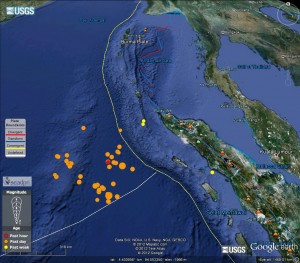M8.6 Earthquake – off the west coast of northern Sumatra 2012-04-11 08:38:37 UTC
The earthquake and tsunami scare off the coast of Sumatra, Indonesia, was a test of disaster preparedness in the region, and we passed fairly.
Wednesday’s earthquake was as rare as rare can get according to seismologist Susan Hough of the US Geological Survey in Pasadena, Calif., who told the Associated Press, “It’s clearly a bit of an odd duck.” Usually earthquakes of this magnitude are subduction quakes, but the one that struck Wednesday is known as a slip-strike, making it much less likely to form a tsunami. However, slip-strike earthquakes are usually far less powerful.
The shocks and aftershocks as of 13 April 2012 11.00am (Malaysian Time):
See also: Aftershocks 12 April 2012, 2012 Indian Ocean earthquake’s wiki and new update in SEADPRI Facebook
The National Geographic explains: ” The earthquake Wednesday (April 11, 2012) only raised the ocean floor about three feet. That is because slip-strike quakes move vertically, not horizontally.”
The shock was followed by a magnitude-8.2 aftershock. Both were strike-slip quakes of “odd magnitudes’
Even more surprising, the 2012 earthquake is most likely related to the 2004 subduction quake. Bradford Hager, a geophysics professor at MIT said, “I would call this an aftershock,” saying it’s not surprising to have slip-strike earthquakes long after an earthquake of the 2004 magnitude, adding the 2012 earthquake was, “in response to an even bigger quake.” Hager went on to explain that the motion of the Indonesian slip-strike is similar to what occurs at the San Andreas Fault in California and is usually far less dangerous because it involves less vertical motion.


